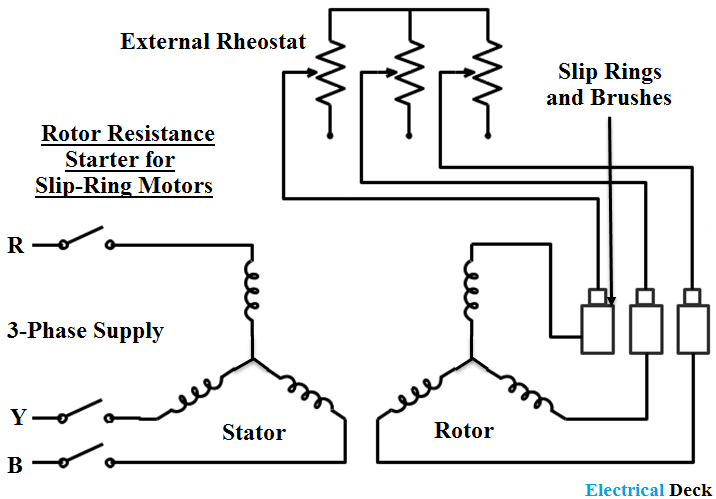The various types of starters used for starting a 3-phase induction motor are,- Full Voltage Starting,
- Direct-on-line (DOL) starter (full voltage starting).
- Reduced Voltage Starting,
- Autotransformer starter.
- Star-delta starter (reduced voltage starting).
- Rotor resistance starter (used for slip ring motors).
- Direct-on-line (DOL) starter (full voltage starting).
- Autotransformer starter.
- Star-delta starter (reduced voltage starting).
- Rotor resistance starter (used for slip ring motors).
The first three starters are used for both squirrel cage and slip ring induction motor. It is therefore recommended that large three-phase squirrel-cage induction motors be started with a reduced voltage applied across the stator terminals at starting. Small motors below 5 HP ratings may however be started direct-on-line (DOL).
Full Voltage Starting :
DOL Starter (direct online starter) :
For small capacity motors having less than 5 hp, the motors can withstand high starting currents due to robust construction. Motors are directly switched on supply lines hence the starter is called Direct Online Starter.
Reduced Voltage Starting :
Auto Transformer Starter :
The voltage applied to the stator can be reduced to the desired value by using a 3-phase star-connected auto-transformer. It contains a suitable change over switch as shown in the below figure.
When the switch is in the 'START' position, a reduced voltage is applied across the stator winding. The amount of voltage applied can be controlled by changing tappings on the auto-transformer. When the motor attains 80% of its normal speed, the change-over switch is thrown into the 'RUN' position.
In the RUN position rated voltage gets applied across the stator winding and the auto-transformer is disconnected from the circuit. The operation of the change-over switch is automatic by using timers and relays. This type of starter is suitable for both start and delta-connected motors. The wiring diagram of an auto-transformer is shown below.
Relation between Starting and Full-load Torque :
Let 'x' be the transformation ratio of the autotransformer. So voltage applied to the stator gets reduced by the fraction 'x'. So if Isc is starting current with rated voltage, then motor starting current, Starting torque reduces by X2 if the applied voltage is reduced by fraction 'x'.
Star-Delta Starter :
The stator phase windings are first connected in the star manner and full voltage is connected across its free terminals. As the motor picks up speed, the windings are connected through a switch and they are re-connected in delta across the supply terminals. The current drawn by the motor from the lines is reduced to 1/√3 as compared to the current it would have drawn if connected in delta.
Rotor Resistance Starter (for slip ring motor) :
In the rotor resistance stator, a variable resistance is connected with the rotor circuit to limit the rotor current. The arrangement is shown in the above figure. The external resistance is inserted in each phase of the rotor circuit through slip rings and brush.
At starting the resistance is kept to its maximum value. As the motor picks up speed, the resistance is gradually down to a low value and finally cut off.
When the motor attains normal speed, the rotor windings are short-circuited through the slip rings and brushes as the external resistance has been removed. This operation may be manual or automatic.
This method not only limits the starting current but also increases the starting torque due to added rotor resistance. This starter is not suitable for squirrel cage induction motors because external resistance can not be inserted in the squirrel-cage rotor.
Comparison Between Various Starters :
| Direct Online Starting | Auto Transformer Starting | Star-delta Starting |
|---|---|---|
| Full voltage is applied to the motor at the time of starting requirement. | The starting voltage can be adjusted according to the starting. | Each winding gets 58% ( 1/√3) of the rated line voltage at the time of starting. |
| The starting current is 5-6 times the full-load current. | The starting current can be reduced as desired. | The starting current is reduced to 1/3 rd that of direct online starting. |
| Only three wires are to be brought out from the motor. | Only three wires are to be brought out from the motor. | Six wires are to be brought out from the motor. |
| Low cost. | High cost. | Low cost. |
| Very easy operation. | Not so easy to operate, a skilled operator is needed. | Not so easy to operate, since the connections are first to be made in star and then in delta either manually or automatically. |
| Used for motors up to 5 HP. | Used for large motor ratings. | Used up to 10 HP motors. |




